IBM705 Computer
 The Merchandise Mart
The Merchandise Mart
|
Mike's first job, following his abbreviated college experience, was at a Chicago-based firm: Field Enterprises Educational Coprporation (FEEC), located in the famed Merchandise Mart, in 1960. One of these departments, called "Systems", was expanding and in need of more people. The staff there (all men) worked with the company's "computer", but they actually needed someone to do clerical work, sometimes including going to other local companies to rent computer time: FEEC had more work than their in-house computer could handle, but other firms sold their excess time to FEEC. FEEC's programmers needed someone to carry computer tapes, punched cards and printouts to and from these firms. Mike did a lot of of actual "computer operator work" and learned much about what computers did. (The computer industry was in its infancy and considered "mysterous" by the general public.) |
|
The IBM705 was the first true "business computer" that IBM produced; it was introduced in 1954 and was marketed into the early 1960s. It was considered one of the most powerful data processing systems of its time, and many companies that required very large amounts of data processing and storage either bought or rented this computer system. The IBM705 used circuit boards of vacuum tubes, resistors and capacitors - so primative compared to today's computers - with an astounding total of 10,000 vacuum tubes! Due to the heat generated by all the computer's elecronics, the system needed massive temperature control (a/c) and "cleanroom" air filtering to keep the equipment cool and clean. The "computer rooms" of that day were always carefully controlled and managed, often creating an aura of mystery to those not working there. |
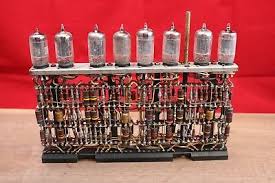 IBM705 Circuit
IBM705 CircuitBoard |
|
When Mike first started at Field Enterprises Educational Corporation, he was delivering boxes and materials to a special climate-controlled room. At the time, there was a large and mysterious electronic machine there that was called "the Computer" (the special room was called "The Computer Room"). Everything associated with this place seemed secretive, as all who worked there were young men in suits...unlike the other employees at FEEC. Mike made enough deliveries there that he got to know the managers there, and the must have considered him a special sort of stockboy, as they asked one day if he'd like to take as test and become a "programmer" (whatever that was). After 6 months in the stockroom, Mike was tired of it and saw a chance to move from that job...even though he had no idea what was involved. With his education and ambitions, he didn't "fit in" with the stockroom people. (Mike intended only to earn enough money to return to Coe and finish college.) He benefitted from the company's desparate need for more programming help, and management noticed him as he moved around the company - real luck, actually. Mike took and passed the test (known as the "IBM Programming Test", the only existing determination vehicle to the fledging programming field). There were no college or commercial classes or schools for this work, which was in its infancy in 1960. Mike was quickly transferred into the "Systems Department", populated with a dozen young men in suits and ties, all with college degrees in various technical disciplines - Mike was out of place there, too. It didn't actually matter to the others in the department, because they were all learning the aspects of the work, too. |
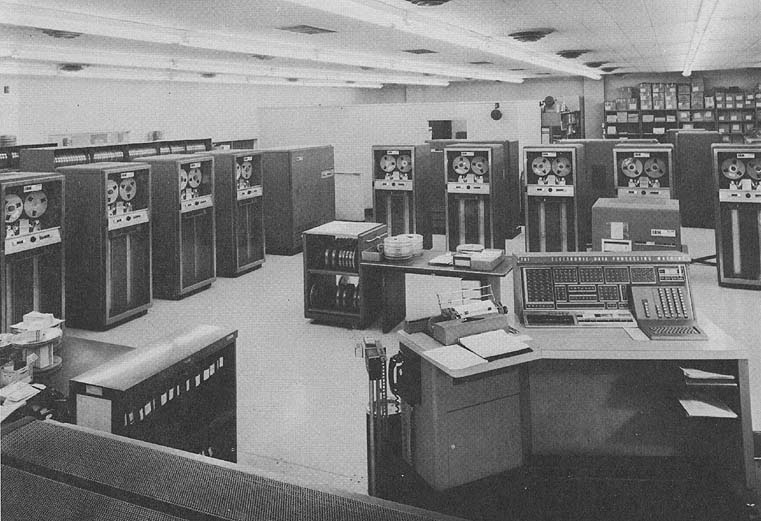 IBM705 Computer
IBM705 Computer(FEEC had 2) |
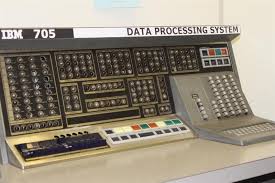 The IBM705
The IBM705"keyboard" |
His first work there was travelling to other local companies that had IBM705 computers, to test the programs that the guys in the department were writing - often at odd hours when those firms could rent time on their computers. During the day, Mike was given a manual on the 705 machine and told to learn the instructions for coding programs; there wre no classes for formal education facilities. At the time, everything was done "On the Job". An "incentive" the department had for new programmers was that, if one's first program assembled and ran, he was awarded a bottle of wine. Incredibly, Mike's first program assembled and ran (it didn't do much of anything useful), and although he was given the prize, he didn't drink! (something "corrected" a few years later...) |
Over the next few years, Mike wrote a lot of computer programs for Field Interprises. Most were applications in support of the company's enormous mail order encyclopedia sales and accounts receivable business, and the firm purchased a second IBM705 system, becoming one of the largest users of the IBM system. He also worked on their IBM 1401 "satellite" computers, becoming FEEC's expert on this computer. All this experience led him to work on new computer acquisition, when these computers' couldn't handle the company's growing work load and had to be replaced.
IBM 1401 Computer
Before large scale computers such as the IBM705 became available, companies with large data processing needs used devices known as "tabulating equipment", much of it made by IBM (hence the company's name, "International Business Machines"). Field Enterprises Educational Corporation was no exception, and they used a lot of these machines: key punches, sorters, readers, accoutning machines, etc. When Mike arrived there, he was receiving and delivering all sorts of materials, such as "IBM cards", printer paper, and other consumables to the "tab shop".
Examples of 1950-1960s Card Tabulating Machines
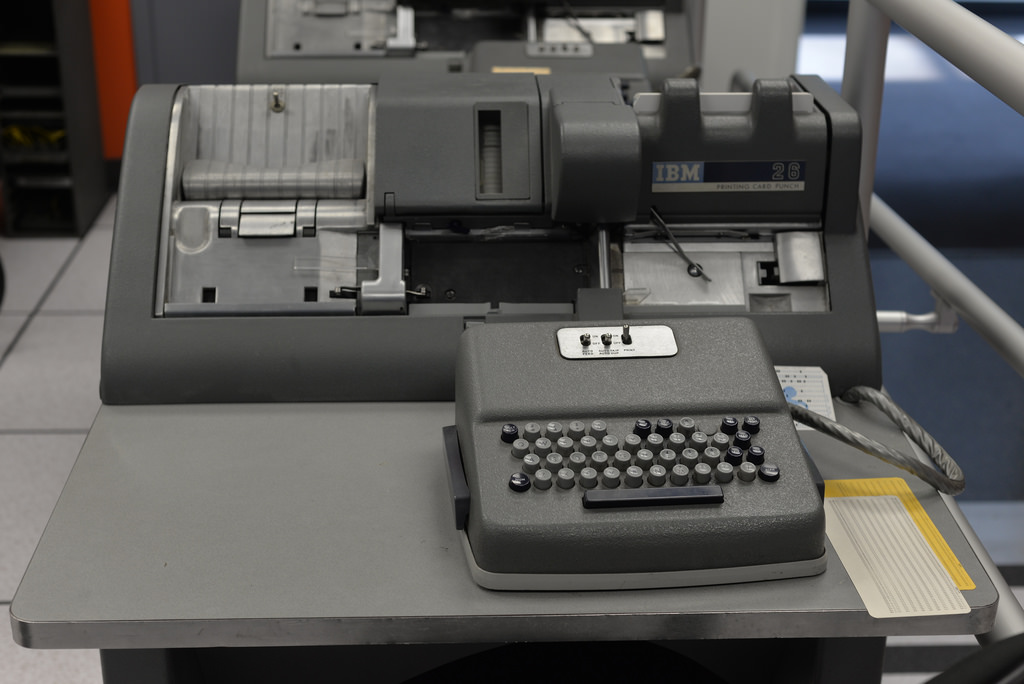 IBM card keypunch machine
IBM card keypunch machine
|
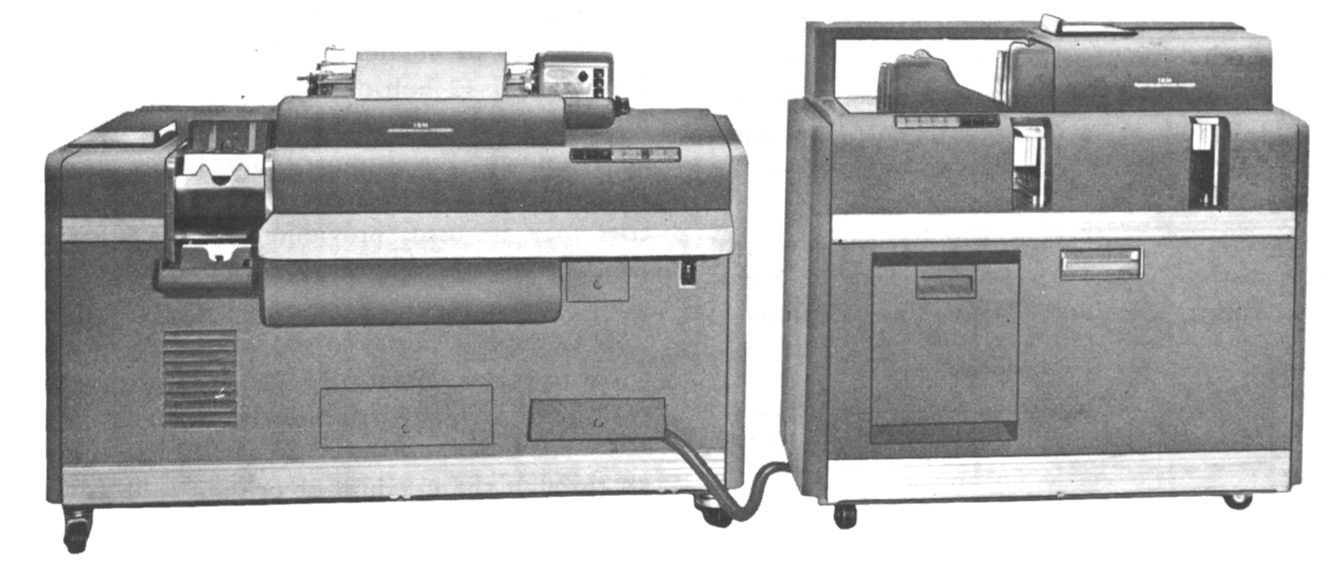 Tab Accounting system
Tab Accounting system
|
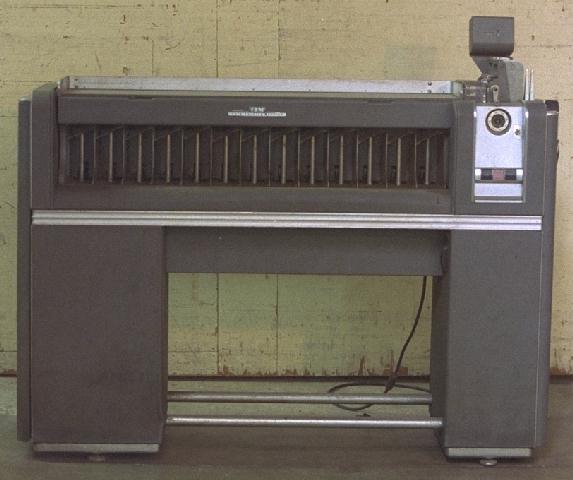 Card sorting machine
Card sorting machine
|
Mike saw these machines operating day and night, but he didn't understand their role until he transferred to the Systems Department and began his programming career on the IBM705. Even with the great power of that computer, many tasks to prepare the data used by the computer required the Tab Shop's work. A small part of his programming work was the "keypunching" of his source code before he could test and debug his computer programs - and he had to "squeeze" his coding sheets into the regular production work. It was important that Mike maintained good relations with that department...
Like so much of the company's data processing growth, the Tab Shop's work had to be upgraded, and Mike was tasked with programming and working with a "replacement computer", the IBM1401. He's unsure why he was assigned this work, but working with and having total command of this computer was quite enjoyable. This system (and some follow-on "satellite" computers) became more increasingly important to FEEC's work, and his broadening knowledge of the firm's computers led to his key role in the search for the replacements for the aging main computers. (Another lucky break...)
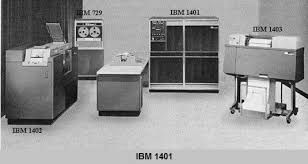 IBM 1401 System
IBM 1401 System
|
Mike seemed to have "free rein" on 1401 development (he's not sure why), and he could develop programs as he saw fit once its basic production work was working. That is, he could experiment on the 1401's system to seek out new ways it could be used. It had some reporting/printing capabilities that weren't yet tapped, and Mike had time to explore... One aspect of the newer technology available on this newer technology was the concept of "program generation": software that generate programms from coded specifications and parameters, rather than machine-leve hardware instructions like the IBM705 computer. This allowed a user/programmer to create application programs easily and quickly by specifying parameters, rather than tedious step-by-step coding. It was FEEC's instroduction into the concept of "high-level" languages, which had not been available before then. |
This became the foundation of programming the computers Mike and the other programmers would use in later computer environments. Programming the computers the company would acquire involved use of computer languages, such as COBOL and ForTran, rather than instruction-by-instruction coding of "assembler" code; Mike found himself having more and more decision-making responsibilities at Field Enterprises Educational Corporation (in spite of his limited formal education...). It wasn't long before he found himself leading the search for bigger and faster computer systems.
IBM 360/370 Computers
The time came for Field Enterprises Educational Corporation to expand its data processing capabilities. A team of computer Operations, Systems (programming) and Finance was formed; Mike was a representative from Systems; The team's task was to evaluate current needs and determine what new systems would best handle the company's growth. Key parts of the evaluation were benchmarking new computers, estimating conversion efforts, training for FEEC staffs, and, of course, costs. Benchmarking of available computers was Mike's main responsibility, and the effort to convert existing applications to new platforms was an important part of that. Mike had plenty to do, and a lot of travel would be needed (to visit sites having computers being evaluated.
FEEC's existing computers were (very old) IBM systems: two IBM705 systems with 10 tape drives and one printer each. Naturally, one of the vendors being evaluated would be IBM, but much had changed in the industry since FEEC had been using such ancient vacuum tube-based architecture - programming and running modern day computers were vastly different. IBM promised and could deliver a relatively easy converion of FEEC's data formats, but a huge challenge awaited the conversion of all existing applications. This was because FEEC had programmed everything in Assembler, would modify by "patching" executeable programs, and had no source code backups. No matter how they changed their computer systems, an enormous rewrite (and redesign) of all applications would be required. In essence, most of the conversion part of the change would be a "wash", regardless of which vendor was selected.
IBM also promised some "comforting extras", as they had great local support, numerous nearby customers that could loan time for FEEC's development and testing, and assurances that, perhaps unlike other vendors, would be in business for the long run. However, as Mike and the team discovered, the new way IBM marketed their systems, called "unbundling", was a serious problem. This new costing method, where all aspects of the system (education, manuals, support, etc.) were priced separately, and while the actual equipment costs seemed low, the total cost to the customer was considerably higher. The true final cost for the system had to be determined before bids could be compared; an unsophistocated customer such as FEEC would need a lot of these "extras".
Mike's technical evaluation took him to other customers' locations, as well as IBM's headquarters in Poughkeepsie, New York. IBM was suggesting that FEEC could get by with their current, but aging, 360 Series computers. Mike and his team thought otherwise, as they knew IBM was soon introducing a newer series, the 370. The two systems were very much alike and compatable, but FEEC was looking at another switch and conversion very soon - costs which had to be factored into the decision. IBM's initial advantage was fading...
GE435 Computer
As Mike's team looked at computer vendors other than IBM for a new computer system for FEEC, the search an evaluation became longer and more complex. It's not as though Large Scale computers were marketed in "computer stores": nothing like that existed at the time. He and his team, after months of research and testing of competing Large Scale computer vendors, recommended to FEEC management replacing the old and failing IBM705, as there were no feasible "uipgrade" options. Mike led the technical eveluation search (but not the financial considerations), and doing so meant travelling across America to various manufacturing sites and installations: GE, Honeywell, Univac, DEC and others.
In this search, Mike traveled often to Phoenix, where a burgeoning large scale computer manufacturing plant was growing in the desert. GE was well-established in the banking computer business (GE 225, etc.), but hadn't really entered the general business market that FEEC sought. The attention Mike received in Phoenix was exciting, but it was the technical capabilities of their new GE435 systems that held significant appeal for the work FEEC was doing. This computer had significant "architecture differences" from the IBM705 that FEEC was using, but those issues existed with any non-IBM systems...and had to be factored into the overall costs involved with switching. Available IBM systems had different costs (e.g. software, education, documentation), as well, and balancing all the pluses and minuses was an enormous task. In the end, Mike and his team picked the GE435 system (2, in fact) to replace the two aging IBM705 systems. This came as an unpleasant surprise to the IBM sales team, who had invested years of support at the FEEC site, fully expecting that FEEC would choose the easier conversion to their 360/370 systems.
The meeting with the IBM team was interesting...and very stressful to Mike. They knew that Mike was primarily responsible for the (rejection) decision, and their plan was to openly discredit him in front of the high level executives and managers in that meeting. It was "no holds barred", and IBM evenly offered to replace Mike with a (more) qualified technical leader...real "hard ball" pressure on the client! After 3 hours (of what was supposed to be a 30 minute meeting), Executive VP Don Milne called a halt to the meeting - which had been difficult for everyone - by saying, "I don't understand all this technical stuff, and regardless of the details I'm sticking with my guy." (Meaning, of course, Mike.) The meeting was over, Mike was vindicated, and FEEC went about ordering a GE435 computer system (later, two such computers).
|
Mike was "shell-shocked" by the meeting, seeing the reality of how IBM worked. For the first time in his career, he soon left work and went down to the Merchandise Mart's cocktail lounge and had a drink with his bosses! In the end, the conversion to the new computer(s) was a huge effort (such tasks always are), and it took a team of FEEC programmers and several GE technical people to accomplish it. Field Enterprises Educational Corporation became a "marquee costomers" for GE, because of its size, as well as having "beaten IBM" to a large account. Mike, and occasionally others from FEEC, made many visits to Phoenix to discuss technical issues, producing several unintended results:
|
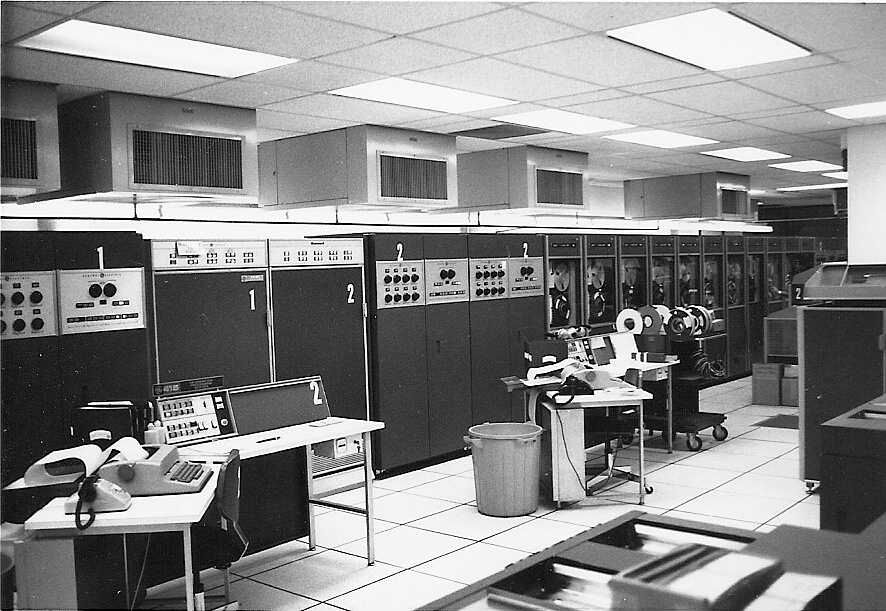 GE 435 System
GE 435 System
|
Honeywell 6000 Computers
Field Enterprises' involvement with GE and Honeywell computers ran parallel to those companies' storied history in the large scale computer business. In the 1960s, GE was rather successful with a lines of mainframe systems designed for banking called the 200 Series (GE-205/215/225/235). GE was also building and marketing two business-oriented (i.e. non-banking) computers at the time: the 400 & 600 series of computers. When FEEC started looking to upgrade and/or replace their 2 aging IBM705 systems, Mike and his team looked at many possibe solutions. The GE 400 Series (415/425/435) was appealing, along with offerings from IBM and the other so-called "7 Dwarfs" (Burroughs, UNIVAC, NCR, Control Data, Honeywell, General Electric and RCA).
The FEEC team considered the systems from these companies, quickly discarding most of them for obvious reasons: not being business-oriented or poor reputation. The remaining "short list" was IBM and either the GE 435 or GE 635. Mike spent a lot of time traveling to Phoenix (where GE's plant was), various IBM and GE customers locations (Seattle, Cedar Rapids, Chicago, New York and other locations), to talk with current customers about their uses and experiences with various systems. This was a long and complicated process, and Mike went to Phoenix often. After several years, FEEC selected the GE 435 system, and the "fun" began...
Switching to a new vendor and converting existing corporate application programs was known to be a major task, and FEEC began a process completely new to them: their first computer system was the IBM705, and there were no "conversion tools" available to do what was needed. One large issue was that newer computers systems used "operating systems" (vendor-supplied software) that had to be learned, used and updated as needed. All vendors had such system software, and GE's was called "GECOS" (to evolve tp "GCOS8"). This co,ponent of the GE systems was a key reason Mike chose GE, because he felt learning and using this software was easier that IBM's O/S, System/370. As for application programming, his team considered that a "wash", since current-day programming languages (e.g. COBOL, ForTran and others) were standardized, and FEEC's people would have to learn something new (most likely COBOL), regardless.
Mike ultimately recommended switching from IBM to GE, a decision that surprised the IBM marketing force in Chicago and resulted in their all-out effort to reverse FEEC's decision...by openly discrediting Mike to his management and offering a "replacement" for him. He was shocked by this attempt to get him fired, but ultimatelt heartened by his management's support. The work to make the change started - a task which would take several years, as GE moved the new computers in and conversions of FEEC's work moved forward. The switch was complete, but something very interesting happened during the process...
GE decided to leave the large scale computer business and sold their business to Honeywell, whose computer division was in Massachusetts, creating anxiety in Phoenix: did FEEC make a huge blunder? A possible switch from Phoenix to Billerica (Honeywell's computer headquarters) concerned the tech staff at FEEC - certainnly Mike, who had become somewhat attached to Phoenix - as there could be a new sales and support team to work with as FEEC's computers needs would grow and change. GE and FEEC had developed a nice working relationship, and the change's impact could be huge. However, the initial fears were largely unfounded, because Honeywell comitted to keeping the Phoenix plant and most of the key management and staff.
As said above, Mike had come to really like Phoenix: the climate, the people, and the easy of transportation. Since he and Libby had been there often, they had already started thinking about moving there. An enormous decision, for sure, but Libby understood that certain FEEC obligations in Mike's managerial role were weighing heavily on him, and she recognized that he might well be happier in a less-demanding role (being a developer, with no management duties). After considerable thought, Mike started making "feelers" to people he knew in Phoenix...
At the same time, Honeywell announced its plans to grow its large scale computer business in Phoenix - in a way that would really benefit FEEC. The type of work FEEC did on the computer wasn't really Honeywell's product strength, which was targeted more toward academic environments. In purchasing GE's computer business, Honeywell redirected its products to the type of commercial work that FEEC needed. This made the company's decision to switch from IBM to GE (now Honeywell) a good one, because FEEC had a good growth path for its business growth.
The new computer line was dubbed the "H6000" line, and it was too long until FEEC bought one to replace the GE435 systems it was using. Concerns about application conversions and other changes were, in this case, minimal, a nice surprise. Mike was, however, still seeking a job change and switch to work at Honeywell, an effort he started in 1970. For him, this couldn't have happened at a worse time, because Honeywell's operation takeover had serious ramifacations: (there was a hiring freeze and layoff there, and Honeywell was very nervous about hiring an employees of a key customer...which FEEC was).
Bad timing or not, Mike continued trying to be hired by Honeywell...and after 3 years it worked out. During that time, Mike was often flying back and forth to Phoenix to work on technical aspects of the switch from the GE435 systems to the new H6000. Many people in Phoenix knew of Mike's wishes, but when he annnounced his planto to FEEC, his fellow workers were stunned. He had many friends there, and Mike and Libby had to endure emotional farewells when they moved to Phoenix in July of 1973.
A short history of the Modern Honeywell computers that led to the biggest and fastest mainframe system on which Mike worked and had significant "selection impact". After some time with FEEC's conversions from the IBM systems to several GE/Honeywell systems, Mike and Libby moved to Phoenix, where Honeywell had purchased the GE mainframe computer operations, and Mike saw Honeywell's major expansions into that market. The growth Honeywell experienced (and Mike's path through it) is detailed here.
Data Products Offline Printers
Year 2000 - "Y2K"
Having started in the computer field in 1960, Mike didn't expect to be involved in several events in the industry. One such event was the so-called "Y2K" (Year 2000), which was the crossing from the 20th century to the 21st century. This universally-ignored problem would occur when 1999 rolled over to 2000: most computer program "date comparisons" would fail.
In the early days, computer memory was small, data storage was expensive and limited, and date comparisons used only the low-order 2 digits of the year: 98 for 1998, 99 for 1999 and so forth. There was little consideration of what would happen when "00" wouldn't be greater than "99", because using the "year shorthand" was implemented universally. Ironically, Mike appproached his boss at one time about this, but he was assured that impacted programs "would be reimplemented long before" the problem would occur. Programmers (and managers) worldwide ignored the problem until it was almost too late...and it took a massive effort to deal with it.
A potential disasterloomed: the nuclear missle systems in Russia and the US were possibly vulnerable to a failure if the programs written years prior didn't recognize that January 1, 2000 was newer than December 31, 1999. Many companies and military complexes stayed prepared for unforseen problems (or worse) as the century rolled over throughout the world. Mike's company, Field Enterprises Educational Corporation, was one of many which had "all hands on deck" to deal with what might occur. Fortunately, the problems everywhere were minor, and the world was saved...
Mike's recollection of all this was that, in the 60s and 70s, he'd wouldn't have to deal with this problem with 2000 being "so far away", because he either wouldn't be working in the industry or be dead. He was, of course, totally wrong...
Teaching Programming in College
In the earlt 1980s Mike decided to expand his programmong knowledge by taking a course at a local community college. The subject was a computer language called Pascal. He doesn't recall why he did this, nor why this strange language interested him...but he signed up and started the class. He discovered it was being taught by a manager he barely knew at Honeywell-Bull named George Mann.
This language, Pascal, really had no commercial purpose, as it was designed to be a language good to teaching the fundamentals of good programming techniques. It had no particular application or value at work, but Mike found it interesting, and he enjoyed the class. After a while, though, he decided the language's structure and style could be applied to the way he solved programming issues at work.
Also at the time, Mike was getting into running, and he was participating in local races (10Ks, Half Marathons, etc.). He developed a friendship with a organizer of these events, named Rob Wallack - a relationship which would have significant impact on his life. Another "connection" he developed was through his volunteer work for Honeywell, sup[porting the Fiesta Bowl Marathon. These two relationships merged when he watched Rob's primitive computer work with crude PCs to score his races. Mike realized that his knowledge of Honeywell's sophistocated scoring technology could be applied to something much smaller, too: Rob Wallack's local races. He offered to develop a PC-based system written in this language he was learning.
Not fully understanding the effort he was committing to, he started working on this project during the summer (when running races in Phoenix wasn't possible), experimenting with this Pascal language. Initially, it was a fun pasttime, and by Fall he had something to try, and Rob allowed him to come to a small event and run his system "in parallel" with his. Results were encouraging, and Mike continued his work to refine and expand his system.
Through this work Mike learned much more about Pascal and its capabilities. He would often encounter George Mann at work, and one day George asked him if he'd be interested in teaching the Pascal class: he was discontinuing his teaching there. Mike gave it some thought and realized he could earn some extra cash exploiting his new-found expertise. He interviewed at the school, passed a simple qualification test, and started teaching the class right away. He found an interest in teaching this way (he had done some presentations and seminars at Honeywell), and it became a regular. part time job for Mike that lasted for more than 5 years. Student interest in the language wained about the time of Mike's tragic bike accident, and his rehabilitation coincided with the college not needing his work. Ultimately, Mike saw his efforts result in several of his students becoming computer programmers - one joining his organization at Honeywell!